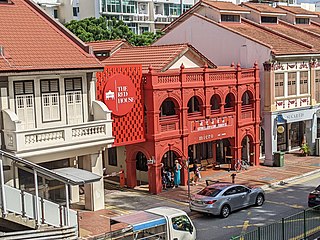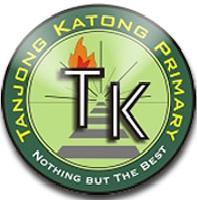
Katong is a residential neighbourhood in the eastern portion of the Central Region of Singapore, within the Marine Parade planning area. The Katong district stretches from Fort Road area to the Joo Chiat area. It used to be located by the sea, before land reclamation towards the south to East Coast Park was created for housing and recreational purposes beginning in the 1960s to 1970s.

Marine Parade is a planning area and residential estate located on the eastern fringe of the Central Region of Singapore. Straddling the tip of the southeastern coast of Pulau Ujong, Marine Parade serves as a buffer between the Central and East regions of the country. Bordering it are the planning areas of Geylang to the north, Kallang to the northwest, Bedok to the northeast, Marina East to the southwest and the Singapore Straits to the south.

Tanjong Rhu, is a subzone within the planning area of Kallang, Singapore, as defined by the Urban Redevelopment Authority (URA). The perimeter of Tanjong Rhu is made up of Nicoll Highway in the north; Mountbatten Road and Fort Road in the east; East Coast Parkway (ECP) in the south; as well as Marina Channel and Kallang Basin in the west. Tanjong Rhu is the largest in terms of physical area among the nine subzones that make up Kallang.
The Canadian International School (CIS) is an international school in Singapore. CIS operates under the International Baccalaureate (IB) Primary, Middle Years, and Diploma programs. The school accepts students from Nursery to Grade 12.

Fort Tanjong Katong, which stood from 1879 to 1901, was one of the oldest military forts built by the former British colonial government of Singapore. The fort gave its name to today's Fort Road, and it used to stand on the grounds of the present Katong Park. Fort Tanjong Katong, the only one of its kind on the eastern side of the island, was part of a series of defensive batteries and fortifications along the southern coast of Singapore, that defended the eastern approaches to the Singapore Harbour and Singapore Town against seaborne attacks. Due to its poor structural design and remoteness, the fort was subsequently abandoned and buried until its rediscovery in 2001. Found with traces of a moat and near intact perimeter wall, the fort was considered by local archaeological experts as one of Singapore's most important archaeological finds of a "true 19-century fort" to date. As a result, an archaeology group has been lobbying for the site to be gazetted as a National Monument. As of May 2010, the National Heritage Board has stated that it has no plans to gazette the fort for the time being.

Tanjong Katong Primary School is a government primary school, located on Seraya Road in Tanjong Katong, under Marine Parade Planning Area in the East Region of Singapore.

Tanjong Rhu MRT station is an underground Mass Rapid Transit (MRT) station on the Thomson–East Coast line (TEL) in Kallang, Singapore. Situated at the junction of Tanjong Rhu Road and Tanjong Rhu Place, the station serves nearby condominiums such as Pebble Bay and Casuarina Cove. Other surrounding landmarks include the Tanjong Rhu Lookout Tower, Singapore Sports Hub and the Tanjong Rhu Footbridge.

Katong Park MRT station is an underground Mass Rapid Transit (MRT) station on the Thomson–East Coast line (TEL). Situated along Meyer Road and adjacent to Katong Park, the station serves Dunman High School and Singapore Swimming School alongside nearby residential developments. The station is operated by SMRT Trains.

Tanjong Katong MRT station is an underground Mass Rapid Transit (MRT) station on the Thomson–East Coast Line (TEL) in Singapore. Located underneath Amber Road at the intersection with Tanjong Katong Road South and Meyer Road, the station serves nearby condominiums such as Aalto and King's Mansion. The station is operated by SMRT Trains.
Regent Alfred John Bidwell, also known as R. A. J. Bidwell, was an English-born architect noted for his colonial era buildings in Singapore. His best-known works include the Raffles Hotel and the Victoria Theatre and Concert Hall in Singapore and Sultan Abdul Samad Building in Kuala Lumpur.

Katong Park is neighborhood park located in Katong, Singapore at the junction of Meyer Road and Fort Road. Built in the 1930s above the buried remains of Fort Tanjong Katong, it was one of Singapore’s oldest parks with the first public bathing pagar and was highly popular with families during the weekends. After the coastal reclamation works in the 1970s, the park lost its sea frontage and declined greatly in popularity. It now remains as a small community park serving nearby residents.
Amber Mansions was a shopping centre and residential building located at the curve between Orchard Road and Penang Road in what is currently known as Dhoby Ghaut, Singapore. Constructed in the 1920s, the shopping centre was one of the first shopping centres in Singapore.

Tanjong Katong Complex is a shopping complex in Geylang Serai, Singapore. Completed in 1982, the complex was the first air-conditioned shopping complex built by the Housing and Development Board and has since become known for servicing the Malay community in the area.
Meyer Flats was an apartment building on Meyer Road in Katong, Singapore. Completed in 1928, it served as a companion block to the Crescent Flats, which was the first apartment building built in Singapore. Designed by Regent Alfred John Bidwell for Manasseh Meyer, both were demolished to make way for a condominium project.
Ngee Ann Building was a building on Orchard Road in Singapore housing both shops and apartments. Built by the Ngee Ann Kongsi and opened in 1957, the rent collected from the building enabled the organisation to establish the Ngee Ann College. It was demolished in 1985 to make way for Ngee Ann City.

Meyer Road is a primary access street in Katong, Singapore. Named in 1921 after Sir Manasseh Meyer, it stretches from Tanjong Rhu Road to Tanjong Katong Road at a length of 1.4km. It is connected to many prominent past and present landmarks such as Katong Park and formerly the Crescent Flats and Meyer Flats as well as Katong Park Hotel. It is nicknamed "the Little India of East Coast" due to the large number of Indian residents living there.

Tanjong Rhu Road is a minor arterial road in Tanjong Rhu, Singapore. A combination of the words Tanjong and pokok rhu, the earliest mention of the road is thought to be in Emanuel Godiho de Erédia's 1604 map of Singapore where it was referred to as Tanjon Ru. In 1828, as a part of the Jackson Plan, Tanjong Rhu was made as a shipyard. However, there were squatters and water pollution in the shipyards, culminating in the government getting rid of them to build luxurious condominiums.

Sea View Hotel was a prominent hotel on Meyer Road in Singapore. Opened in 1906, it was converted from a bungalow owned by businessman Sir Manasseh Meyer, the road's namesake. In 1923, the hotel came under the ownership of the Sarkies Brothers, prominent hoteliers, after which it received extensive refurbishments. In its heyday in the 1930s, it was popular, especially with those who had recently recovered from an illness. The hotel suffered from several strikes in its final years of operation. It closed in 1964, after which it was demolished. Another hotel, also named Sea View Hotel, opened near the former premises of the original hotel in 1969.
30 Meyer Road is a bungalow on Meyer Road, Singapore. Designed by colonial architect Eric Vernon Miller, it was purchased by entrepreneur Jack Sim, who restored the building.

61 Meyer Road was a bungalow on Meyer Road, Singapore. It was built by Sir Manasseh Meyer, who died shortly after its completion. It then served as the residence of businessman Parkcane C. Hwang.













